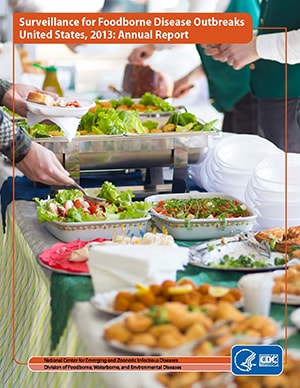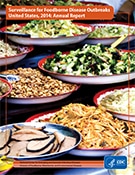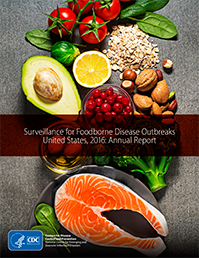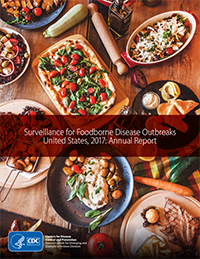Annual Summaries of Foodborne Outbreaks
CDC publishes annual summaries of domestic foodborne disease outbreaks based on reports provided by state, local, and territorial health departments. These summaries help public health practitioners better understand the germs, foods, settings, and contributing factors (for example, food not kept at the right temperature) involved in these outbreaks. They also can help identify emerging foodborne disease threats and can be used to shape and assess outbreak prevention measures. Learn more >
A Brief History of U.S. Foodborne Disease Outbreak Reporting
- 1923: The Public Health Service begins publishing annual summaries of foodborne disease outbreaks linked to milk.
- 1938: The Public Health Service expands reporting to all foodborne outbreaks.
- 1961: CDC, then called the Communicable Disease Center, takes over reporting from the Public Health Service.
- 1961–1965: CDC provides outbreak statistics and accounts of individual outbreaks in the Morbidity and Mortality Weekly Report (MMWR).
- 1966: In response to growing interest in foodborne diseases, CDC resumes publishing annual summaries of foodborne disease outbreaks.
- 1966–1982: CDC publishes outbreak data as stand-alone booklets.
- 1982–2010: CDC returns to publishing reports in MMWR.
- 2011: CDC begins to post annual summaries online.
Annual Reports: 2011–2017
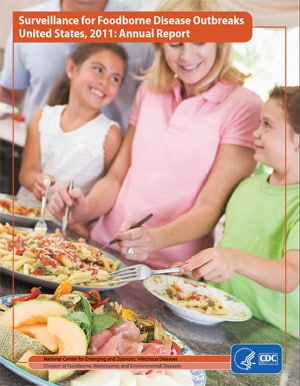
- Surveillance for Foodborne Disease Outbreaks — United States, 2011 pdf icon[PDF – 20 pages]
- Figure: pdf icon[PDF – 20 pages] Rate of reported outbreaks by state and etiology group
- Table 1 pdf icon[PDF – 20 pages]: Outbreaks, illnesses, and hospitalizations by etiology
- Table 2a pdf icon[PDF – 20 pages]: Outbreaks and illnesses by food category
- Table 2b pdf icon[PDF – 20 pages]: Most common pathogen-food categories resulting in outbreaks, illnesses, hospitalizations, and deaths
- Table 3a pdf icon[PDF – 20 pages]: Outbreaks and illnesses by location of food preparation
- Table 3b pdf icon[PDF – 20 pages]: Outbreaks and illnesses by etiology and location of food preparation
- Appendix pdf icon[PDF – 20 pages]: Outbreaks by etiology and contributing factors
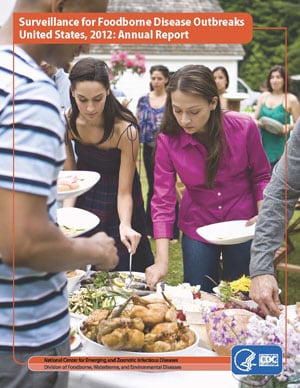
- Surveillance for Foodborne Disease Outbreaks — United States, 2012 pdf icon[PDF – 20 pages]
- Figure: pdf icon[PDF – 20 pages] Rate of reported outbreaks by state and etiology group
- Table 1 pdf icon[PDF – 20 pages]: Outbreaks, illnesses, and hospitalizations by etiology
- Table 2a pdf icon[PDF – 20 pages]: Outbreaks and illnesses by food category
- Table 2b pdf icon[PDF – 20 pages]: Most common pathogen-food categories resulting in outbreaks, illnesses, hospitalizations, and deaths
- Table 3a pdf icon[PDF – 20 pages]: Outbreaks and illnesses by location of food preparation
- Table 3b pdf icon[PDF – 20 pages]: Outbreaks and illnesses by etiology and location of food preparation
- Appendix pdf icon[PDF – 20 pages]: Outbreaks by etiology and contributing factors
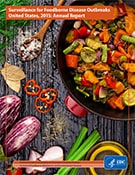
- Surveillance for Foodborne Disease Outbreaks — United States, 2015 pdf icon[PDF – 24 pages]
- Highlights of the 2015 report
- Top 5 Food-Germ Pairs Causing Outbreaks in 2015 pdf icon[PDF – 1 page] [text-version]
- Top 5 Food-Germ Pairs Causing Outbreak-associated Illnesses in 2015 pdf icon[PDF – 1 page] [text-version]
MMWR Reports: 1982–2015*
- Surveillance for Foodborne Disease Outbreaks — United States, 1998–2008
- Appendix – Number of foodborne disease outbreaks by etiology and contributing factor, Foodborne Disease Outbreak Surveillance System — United States, 1998–2008 pdf icon[PDF – 4 pages]
- CDC Feature – Salmonella in Eggs: An Unwelcome Summer Visitor
- Surveillance for Foodborne Disease Outbreaks — United States, 2009–2010
- Expanded Table 2 – Attribution to specific food commodities pdf icon[PDF – 4 pages], 2009–2010
- Table 3 – Settings where food was eaten pdf icon[PDF – 3 pages], 2009–2010
- Table 4 – Contributing factors pdf icon[PDF – 3 pages], 2009–2010
- Table 5 – Settings where food was prepared pdf icon[PDF – 3 pages], 2009–2010
* Some of the documents in this section, due to their historical nature, are not able to be provided in an accessible (508-compliant) format. These are archived / historical PDFs that are no longer being updated.
Page last reviewed: September 12, 2019
